Determination of Exploitable Coefficient of Coral Island Freshwater Lens Considering the Integrated Effects of Lens Growth and Contraction
Abstract
:1. Introduction
2. Study Area
3. Materials and Methods
3.1. Conceptual Model
3.2. Parameter Setting of Numerical Model
4. Results and Discussion
4.1. Growth and Contraction of Freshwater Lens under Natural Conditions
4.1.1. Growth Characteristics and Stage Division of Freshwater Lens
- Stage I: 0–20 years, two extremely thin freshwater areas are formed underground on both sides near the middle of the island. The freshwater lens develops rapidly in the form of a “doughnut”, but the central thickness increases slowly. During this stage, the main role of precipitation recharge is to dilute and flush the salinity of the original groundwater under the island. The groundwater velocity near the middle of the island is the largest;
- Stage II: 20–40 years, this stage is the main stage for the stable growth of the freshwater lens. The freshwater on both sides near the middle of the island are combined into one. The maximum thickness of the freshwater lens increases synchronously with the central thickness, and the central thickness increases significantly faster than Stage I. during this stage, a large great deal of freshwater seeps into the freshwater lens through the surface as the precipitation continues to recharge the groundwater, the thickness of the upper freshwater of the lens becomes larger, and the interface between freshwater and saltwater becomes deeper. Meanwhile, the salinity gradient becomes larger, the corresponding vertical mixing weakens, and the horizontal range of the freshwater lens gradually expands;
- Stage III: After 40 years, the thickness of the freshwater lens increases slowly. After 45 years, the maximum thickness of the freshwater lens is stabilized. Later, the central thickness increases slowly, and reaches the maximum in 60 years. During this stage, the supply and discharge reach a dynamic balance, the thickness and scope of the freshwater lens will not increase, and the freshwater lens will enter a relatively stable status.
4.1.2. Seasonal Variation in Freshwater Lens
4.2. Degradation and Recovery of Freshwater Lens under Pumping Conditions
4.3. Calculation of the Safe Exploitable Coefficient
5. Conclusions
Author Contributions
Funding
Institutional Review Board Statement
Informed Consent Statement
Data Availability Statement
Acknowledgments
Conflicts of Interest
References
- Chui, T.F.M.; Terry, J.P. Influence of sea-level rise on freshwater lenses of different atoll island sizes and lens resilience to storm-induced salinization. J. Hydrol. 2013, 502, 18–26. [Google Scholar] [CrossRef]
- Gohar, A.A.; Cashman, A.; Ward, F.A. Managing food and water security in Small Island States: New evidence from economic modelling of climate stressed groundwater resources. J. Hydrol. 2019, 569, 239–251. [Google Scholar] [CrossRef]
- UNESCO. Small Island Developing States—UNESCO’s Action Plan; Ikhlef, K., Nakashima, D., Eds.; United Nations Educational, Scientific and Cultural Organization: Paris, France, 2016; 32p. [Google Scholar]
- Gingerich, S.B.; Voss, C.I.; Johnson, A.G. Seawater-flooding events and impact on freshwater lenses of low-lying islands: Controlling factors, basic management and mitigation. J. Hydrol. 2017, 551, 676–688. [Google Scholar] [CrossRef]
- White, I.; Falkland, T. Management of freshwater lenses on small Pacific islands. Hydrogeol. J. 2010, 18, 227–246. [Google Scholar] [CrossRef]
- Shuhei, Y.; Satoshi, I.; Tsutomu, K.; Kazuhisa, K.; Takeo, T.; Katsushi, S. Using hydrogeochemical indicators to interpret groundwater flow and geochemical evolution of a freshwater lens on Majuro Atoll, Republic of the Marshall Islands. Hydrogeol. J. 2020, 28, 1053–1075. [Google Scholar]
- Fetter, C. Position of the saline water interface beneath oceanic islands. Water Resour. Res. 1972, 8, 1307–1315. [Google Scholar] [CrossRef]
- Bokuniewicz, H.; Pavlik, B. Groundwater seepage along a barrier island. Biogeochemistry 1990, 10, 257–276. [Google Scholar] [CrossRef]
- Bryan, E.; Meredith, K.T.; Baker, A.; Post, V.E.; Andersen, M.S. Island groundwater resources, impacts of abstraction and a drying climate: Rottnest Island, Western Australia. J. Hydrol. 2016, 542, 704–718. [Google Scholar] [CrossRef]
- Schneider, J.C.; Kruse, S.E. A comparison of controls on freshwater lens morphology of small carbonate and siliciclastic islands: Examples from barrier islands in Florida, USA. J. Hydrol. 2003, 284, 253–269. [Google Scholar] [CrossRef]
- Underwood, M.R.; Peterson, F.L.; Voss, C.I. Groundwater lens dynamics of atoll islands. Water Resour. Res. 1992, 28, 2889–2902. [Google Scholar] [CrossRef]
- Vacher, H.L.; Wallis, T. Comparative hydrogeology of fresh-water lenses of Bermuda and Great Exuma Island, Bahamas. Groundwater 1992, 30, 15–20. [Google Scholar] [CrossRef]
- Wallace, C.D.; Bailey, R.T. Geohydrologic factors governing atoll island groundwater resources. J. Hydrol. Eng. 2017, 22, 05017004. [Google Scholar] [CrossRef]
- Congzhi, Z.; Li, H.; Qin, Y.; Zhendong, F. Three-dimensional numerical simulation of freshwater lens in coral islands. J. Hydraul. Eng. 2010, 41, 560–566. [Google Scholar]
- Yao, Y.; Andrews, C.; Zheng, Y.; He, X.; Babovic, V.; Zheng, C. Development of fresh groundwater lens in coastal reclaimed islands. J. Hydrol. 2019, 573, 365–375. [Google Scholar] [CrossRef]
- Li, Y.; Shu, L.; Zhen, L.; Li, H.; Wang, R.; Opoku, P. Laboratory Physical Experiments on the Saltwater Upconing and Recovery of Island Freshwater Lenses: Case Study of a Coral Island, China. Water 2021, 13, 1137. [Google Scholar] [CrossRef]
- Dose, E.J.; Stoeckl, L.; Houben, G.J.; Vacher, H.L.; Vassolo, S.; Dietrich, J.; Himmelsbach, T. Experiments and modeling of freshwater lenses in layered aquifers: Steady state interface geometry. J. Hydrol. 2014, 509, 621–630. [Google Scholar] [CrossRef]
- Post, V.E.; Bosserelle, A.L.; Galvis, S.C.; Sinclair, P.J.; Werner, A.D. On the resilience of small-island freshwater lenses: Evidence of the long-term impacts of groundwater abstraction on Bonriki Island, Kiribati. J. Hydrol. 2018, 564, 133–148. [Google Scholar] [CrossRef]
- Fu, W.; Moore, J.K.; Primeau, F.W.; Lindsay, K.; Randerson, J.T. A growing freshwater lens in the Arctic Ocean with sustained climate warming disrupts marine ecosystem function. J. Geophys. Res. Biogeosci. 2020, 125, e2020JG005693. [Google Scholar] [CrossRef]
- Sulzbacher, H.; Wiederhold, H.; Siemon, B.; Grinat, M.; Igel, J.; Burschil, T.; Günther, T.; Hinsby, K. Numerical modelling of climate change impacts on freshwater lenses on the North Sea Island of Borkum using hydrological and geophysical methods. Hydrol. Earth Syst. Sci. 2012, 16, 3621–3643. [Google Scholar] [CrossRef] [Green Version]
- Ling, Z.; Shu, L.; Sun, Y.; Wang, R.; Li, Y. Impact of island urbanization on freshwater lenses: A case study on a small coral island. Water 2021, 13, 3272. [Google Scholar] [CrossRef]
- Wang, R.; Shu, L.; Li, Y.; Opoku, P.A. Pumping Well Layout Scheme Design and Sensitivity Analysis of Total Critical Pumping Rates in Coral Island Based on Numerical Model. Water 2021, 13, 3215. [Google Scholar] [CrossRef]
- Lloyd, J.; Miles, J.; Chessman, G.; Bugg, S. A ground water resources study of a pacific ocean atoll-tarawa, gilbert islands 1. Jawra. J. Am. Water Resour. Assoc. 1980, 16, 646–653. [Google Scholar] [CrossRef]
- Bailey, R.T.; Jenson, J.W.; Olsen, A.E. Estimating the ground water resources of atoll islands. Water 2010, 2, 1–27. [Google Scholar] [CrossRef]
- Peterson, F.L. Hydrogeology of the Marshall Islands. Dev. Sedimentol. 2004, 54, 611–636. [Google Scholar] [CrossRef]
- Ibrahim, S.A.; Bari, M.R.; Miles, L. Water Management in Maldives with Special Emphasis on Desalination. In Proceedings of the Pacific Regional Consultation on Water in Small Island Countries, July 29th–August 3rd 2002; Carpenter, C., Stubbs, J., Overmars, M., Eds.; Asian Development Bank and South Pacific Applied Geoscience Commission: Sigatoka, Fiji; Available online: http://citeseerx.ist.psu.edu/viewdoc/download?doi=10.1.1.113.913&rep=rep1&type=pdf (accessed on 17 November 2016).
- Pauw, P.S.; van der Zee, S.E.; Leijnse, A.; Oude Essink, G.H. Saltwater upconing due to cyclic pumping by horizontal wells in freshwater lenses. Groundwater 2016, 54, 521–531. [Google Scholar] [CrossRef]
- Langevin, C.D.; Shoemaker, W.B.; Guo, W. MODFLOW-2000. The US Geological Survey Modular Ground-Water Model–Documentation of the SEAWAT-2000 Version with the Variable-Density Flow Process (VDF) and the Integrated MT3DMS Transport Process (IMT); Center for Integrated Data Analytics Wisconsin Science Center Wisconsin: Madison, WI, USA, 2000; pp. 1258–2331. [Google Scholar]
- Harbaugh, A.W.; Banta, E.R.; Hill, M.C.; McDonald, M.G. Modflow-2000, the U. S. Geological Survey Modular Ground-Water Model-user Guide to Modularization Concepts and the Ground-Water Flow Process; United States Department of the Interior: Washington, DC, USA, 2000. [Google Scholar]
- Anderson, M.P.; Woessner, W.W.; Hunt, R.J. Applied Groundwater Modeling: Simulation of Flow and Advective Transport, 2nd ed.; Academic Press: Cambridge, MA, USA, 2015. [Google Scholar]
- Zhou, C.; Qiao, H.; Du, R. Simulation and exploitation of the freshwater lens in Coral Island. J. Logist. Eng. Univ. 2016, 32, 1–10. [Google Scholar]
- Sheng, C.; Xu, H.; Zhang, Y.; Zhang, W.; Rem, Z. Hydrological properties of calcareous sands and its influence on formation of underground freshwater lens on islands. J. Jilin Univ. 2020, 50, 1127–1138. (In Chinese) [Google Scholar]
- Oberdorfer, J.A.; Hogan, P.J.; Buddemeier, R.W. Atoll Island Hydrogeology: Flow and Freshwater Occurrence in a Tidally Dominated System. J. Hydrol. 1990, 120, 327–340. [Google Scholar] [CrossRef]
- Holding, S.; Allen, D. From days to decades: Numerical modelling of freshwater lens response to climate change stressors on small low-lying islands. Hydrol. Earth Syst. Sci. 2015, 19, 933–949. [Google Scholar] [CrossRef] [Green Version]
- World Health Organization. Guidelines for Drinking-Water Quality, 3rd ed.; World Health Organization: Geneva, Switzerland, 2004; Volume 1. [Google Scholar]
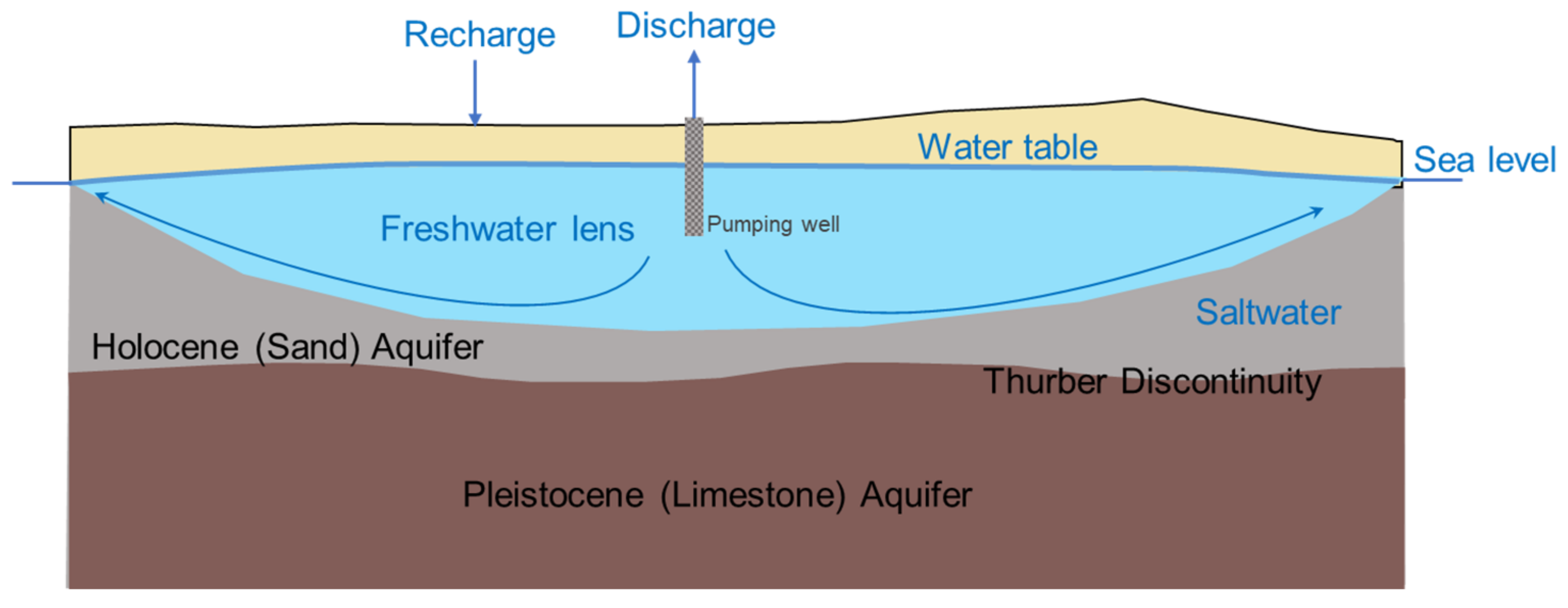
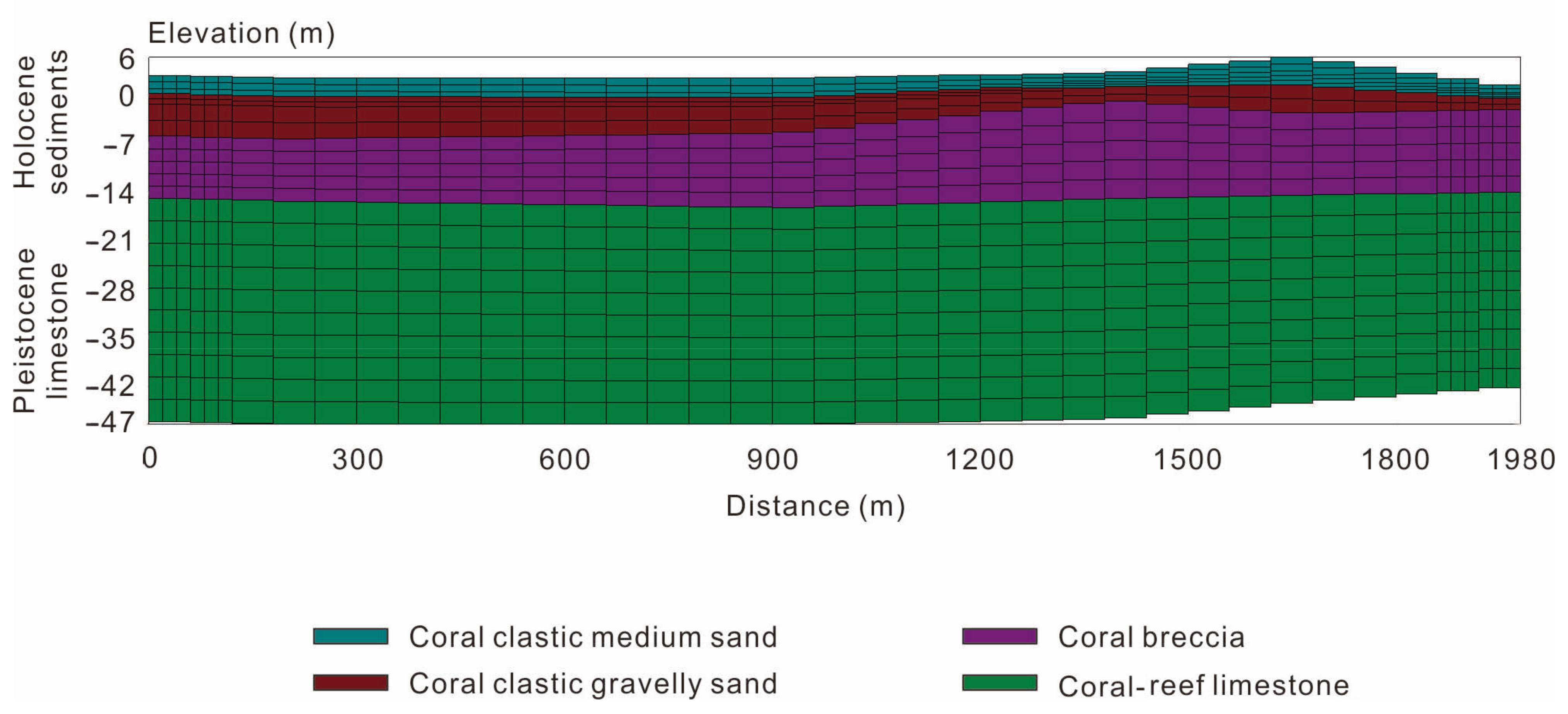
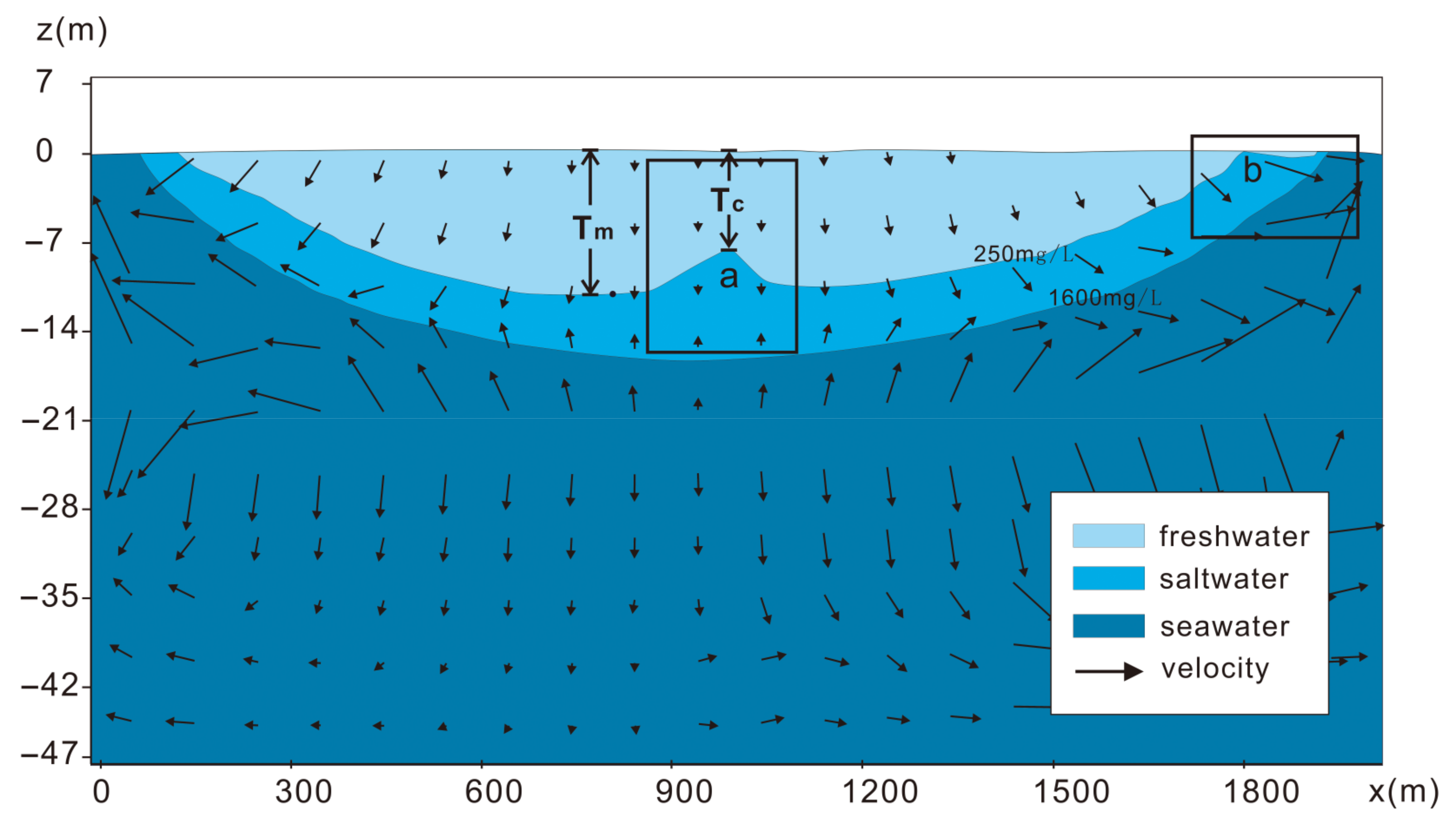

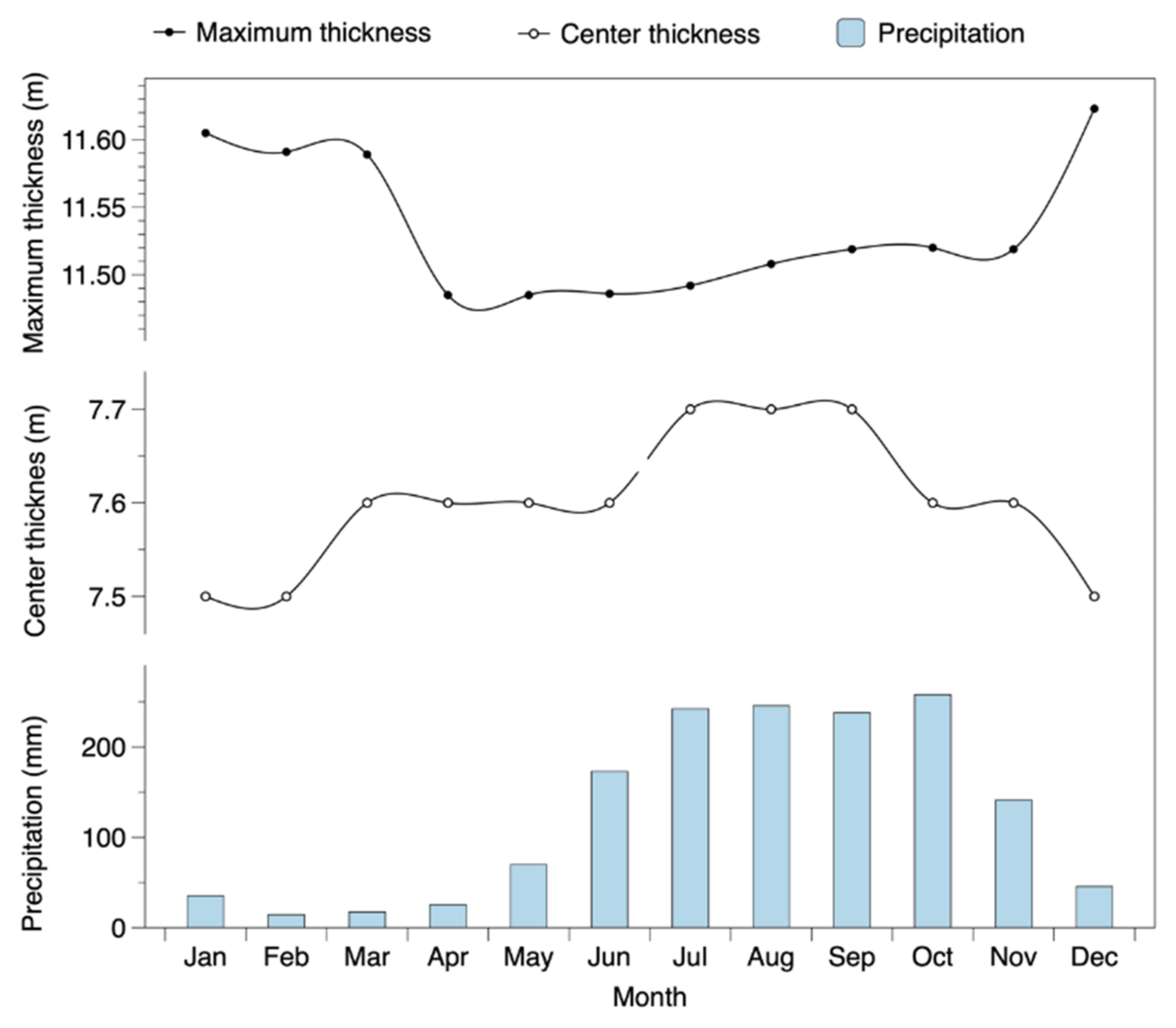
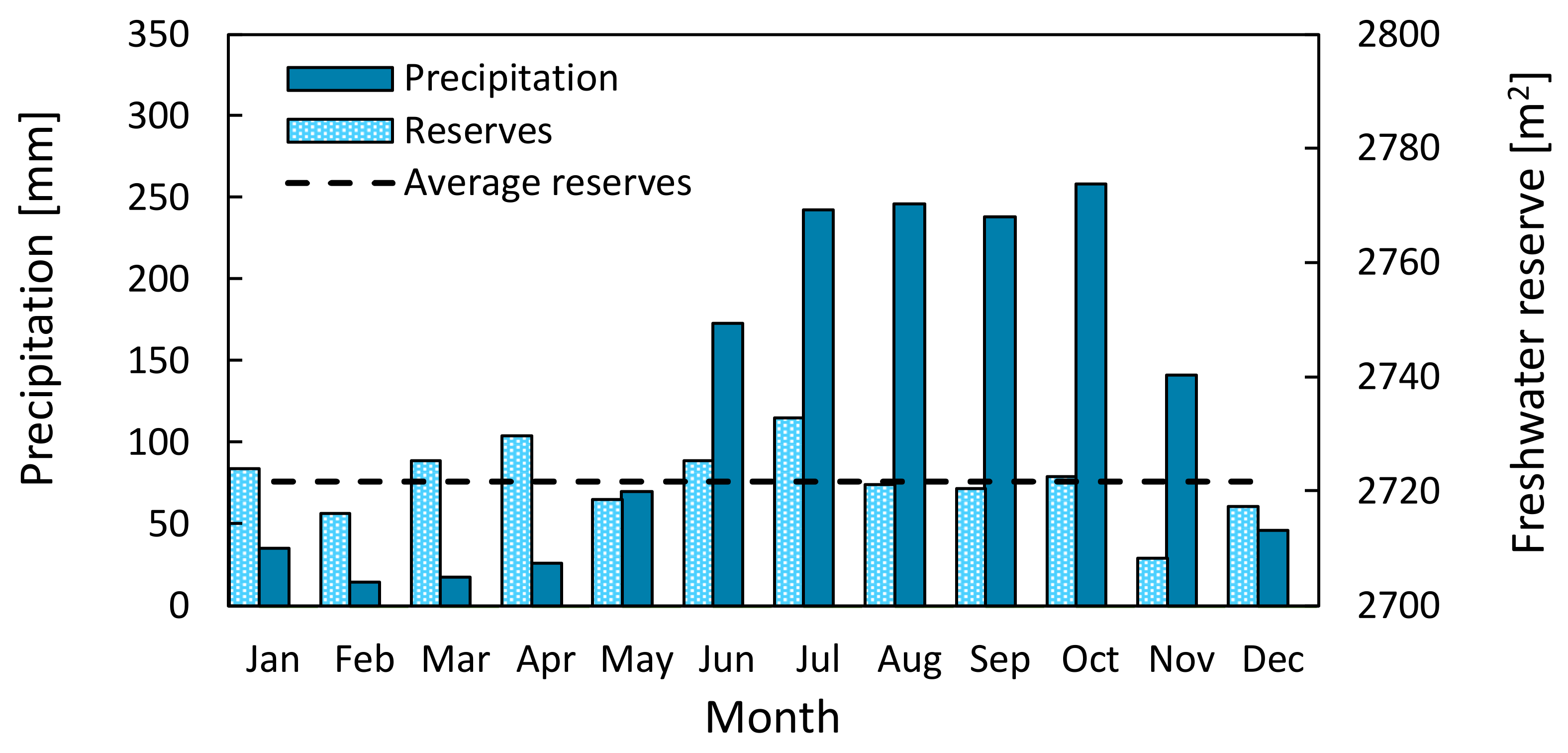

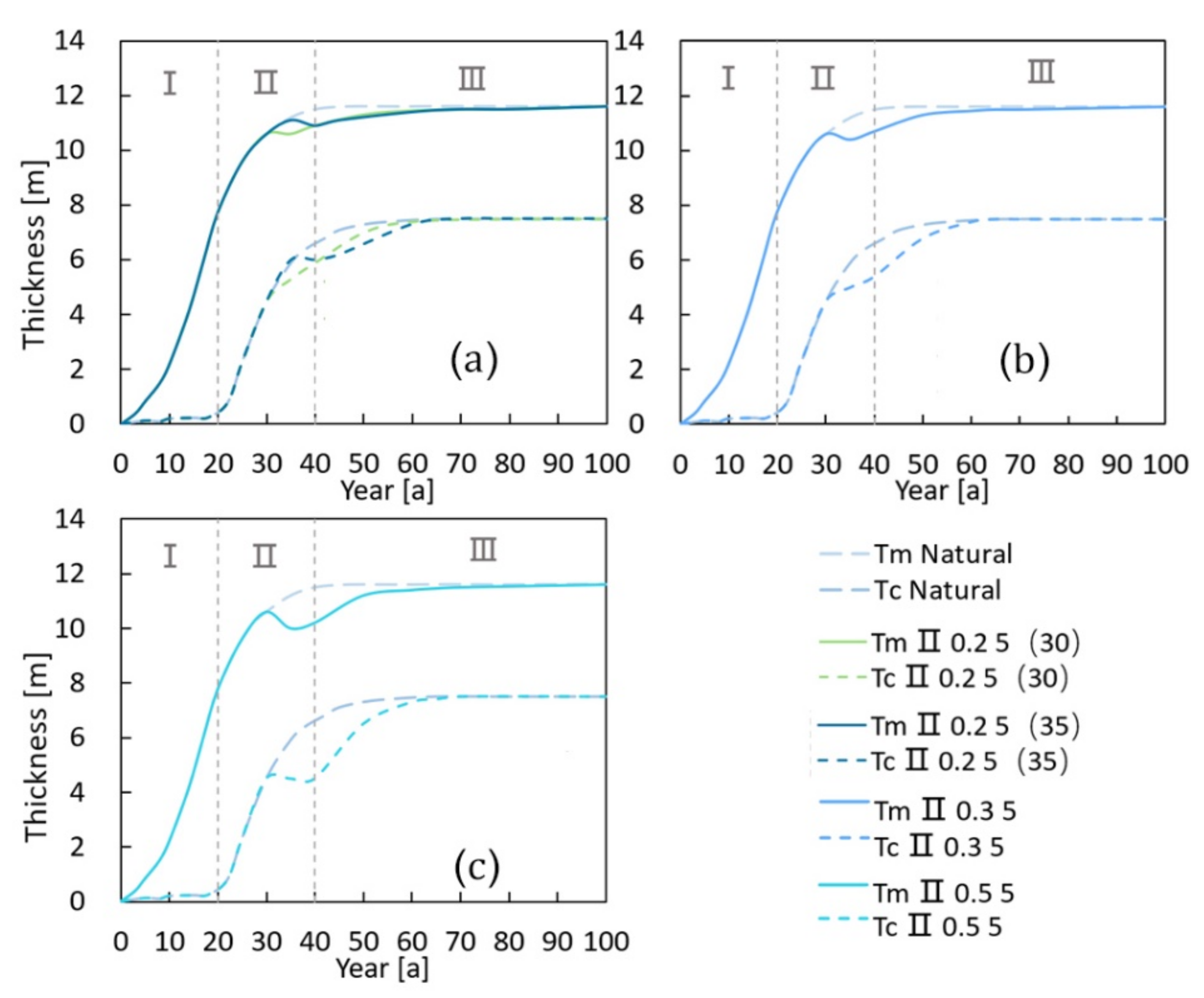


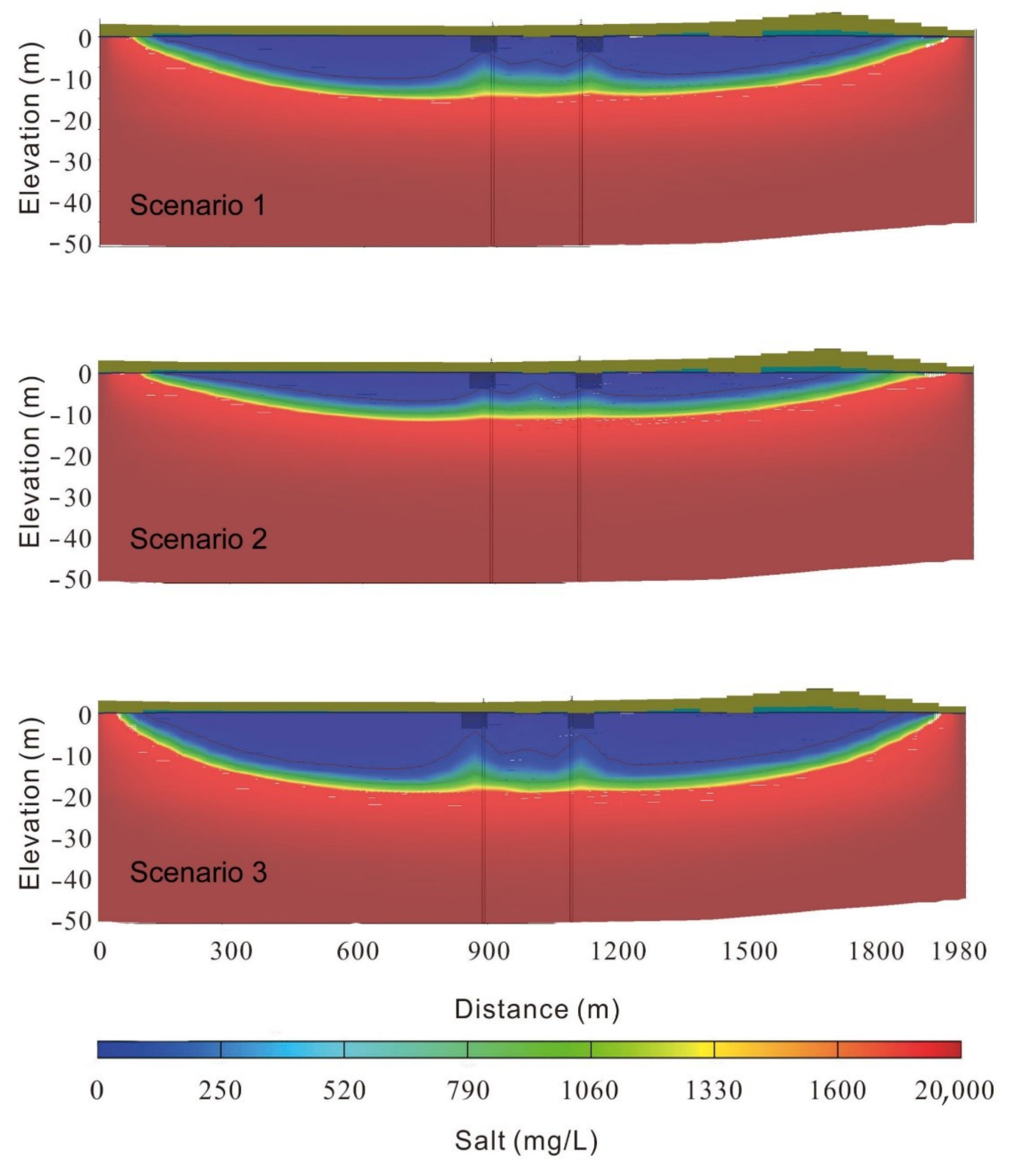
| Settings | Parameter | Units | Value |
|---|---|---|---|
| Basic setup | Island width | m | 1980 |
| Thickness | m | 50 | |
| Grid | \ | 41 × 22 | |
| Simulated time step | d | 36,525 | |
| Flow model | Recharge | mm/y | Monthly average recharge |
| Effective porosity | \ | 0.25–0.45 | |
| Holocene K | m/d | 60–150 | |
| Pleistocene K | m/d | 1000 | |
| Specific yield | \ | 0.1–0.2 | |
| Transport model | Longitudinal dispersivity | m | 5 |
| Density-dependent model | Reference fluid density | kg/m3 | 1000 |
| Seawater density | kg/m3 | 1025 |
| Stages | Pumping Duration (y) | Pumping Rates (m3/d) | Minimum Value (m) | Thickness Variation (m) | Recovery Time (y) | |||
|---|---|---|---|---|---|---|---|---|
| Tm | Tc | Tm | Tc | Tm | Tc | |||
| II | 5(30) | 0.2 | 10.6 | 5.3 | 0 | 0.8 | 35 | 35 |
| 5(35) | 0.2 | 10.9 | 6 | −0.2 | 0 | 25 | 25 | |
| 5 | 0.3 | 10.4 | 5 | −0.2 | 0.4 | 30 | 30 | |
| 5 | 0.5 | 10 | 4.5 | −0.6 | 0 | 35 | 35 | |
| III | 5 | 0.2 | 11.1 | 6.8 | −0.45 | −0.6 | 35 | 25 |
| 5 | 0.3 | 11 | 6.4 | −0.55 | −1 | 35 | 30 | |
| 5 | 0.5 | 10.5 | 5.7 | −1.05 | −1.7 | 35 | 35 | |
| Test Number | Well Layout Plan | Results | |||||
|---|---|---|---|---|---|---|---|
| Screen Length (m) | Number of Wells | Distance between Wells (m) | QT (m3/d) | Tc (m) | Tm (m) | ρ | |
| 1 | 4 | 4 | 100 | 0.407 | 4.3 | 9.2 | 0.17 |
| 2 | 2 | 4 | 200 | 0.73 | 1.1 | 7.4 | 0.30 |
| 3 | 2 | 6 | 150 | 0.907 | 0.5 | 6.1 | 0.37 |
| 4 | 3 | 4 | 150 | 0.555 | 2.3 | 8.2 | 0.23 |
| 5 | 2 | 2 | 100 | 0.33 | 2.2 | 9.8 | 0.13 |
| 6 | 4 | 6 | 200 | 0.735 | 1.7 | 7 | 0.30 |
| 7 | 3 | 6 | 100 | 0.562 | 2.8 | 7.5 | 0.23 |
| 8 | 4 | 2 | 150 | 0.215 | 3.3 | 10 | 0.09 |
| 9 | 3 | 2 | 200 | 0.33 | 4.6 | 9.8 | 0.13 |
| Max ρ | 2 | 6 | 150 | 0.907 | 0.5 | 6.1 | 0.37 |
| Min ρ | 4 | 2 | 150 | 0.215 | 3.3 | 10 | 0.09 |
| Parameter Combinations | Results | ||||||
|---|---|---|---|---|---|---|---|
| ΔR* | ΔK* | Δn* | Tm (m) | QT (m3/d) | Tr | ρ | |
| Scenario 1: | 0 | 0 | 0 | 9.3 | 0.330 | 35 | 0.13 |
| Scenario 2: | −30% | 30% | −30% | 6.3 | 0.174 | 31 | 0.1 |
| Scenario 3: | 30% | −30% | 30% | 12.6 | 0.573 | 37.1 | 0.18 |
Disclaimer/Publisher’s Note: The statements, opinions and data contained in all publications are solely those of the individual author(s) and contributor(s) and not of MDPI and/or the editor(s). MDPI and/or the editor(s) disclaim responsibility for any injury to people or property resulting from any ideas, methods, instructions or products referred to in the content. |
© 2023 by the authors. Licensee MDPI, Basel, Switzerland. This article is an open access article distributed under the terms and conditions of the Creative Commons Attribution (CC BY) license (https://creativecommons.org/licenses/by/4.0/).
Share and Cite
Wang, R.; Shu, L.; Zhang, R.; Ling, Z. Determination of Exploitable Coefficient of Coral Island Freshwater Lens Considering the Integrated Effects of Lens Growth and Contraction. Water 2023, 15, 890. https://doi.org/10.3390/w15050890
Wang R, Shu L, Zhang R, Ling Z. Determination of Exploitable Coefficient of Coral Island Freshwater Lens Considering the Integrated Effects of Lens Growth and Contraction. Water. 2023; 15(5):890. https://doi.org/10.3390/w15050890
Chicago/Turabian StyleWang, Ran, Longcang Shu, Rongrong Zhang, and Zihan Ling. 2023. "Determination of Exploitable Coefficient of Coral Island Freshwater Lens Considering the Integrated Effects of Lens Growth and Contraction" Water 15, no. 5: 890. https://doi.org/10.3390/w15050890
APA StyleWang, R., Shu, L., Zhang, R., & Ling, Z. (2023). Determination of Exploitable Coefficient of Coral Island Freshwater Lens Considering the Integrated Effects of Lens Growth and Contraction. Water, 15(5), 890. https://doi.org/10.3390/w15050890







